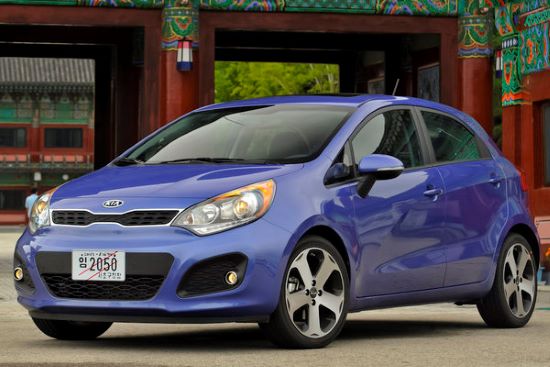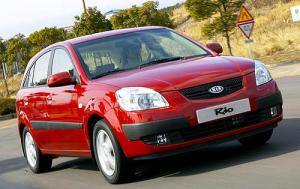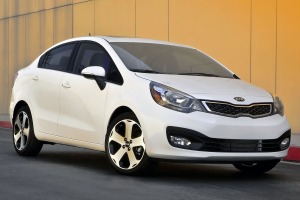
The Kia Rio has been a well-regarded subcompact car, offering efficient use of space, good gas mileage, and typically more affordable pricing. And due to today's high-priced used car market, many shoppers are looking for "older" models that have aged well as a way to save significant dollars.
And by "older", I am generally referring to 10+ year-old vehicles, so those produced within the Rio's second and third generations, which covered the 2006 - 2017 model years.
But clearly, prospective buyers must weigh the benefits of affordability and performance against potential drawbacks, such as higher maintenance needs and outdated technologies.
So here, ...
- First, we'll look at what history has proven about the reliability of second and third generation Rio models (again, 2006 - 2017).
Then we'll do an overview of both generation's features and characteristics so potential buyers can get to know the vehicle better.
- We'll then list each generation's possible mechanical issues as reported by owners so they can be checked before buying one today.
- And then we'll review the overall pros and cons of buying an older Rio.
2006- 2017 Kia Rio Reliability
The Kia Rio’s reliability reputation for these model years is a bit mixed. While it offers good value, affordability, and improvements in newer models, it has faced recurring mechanical and build quality issues. And while many owners have had positive experiences, others have encountered notable problems.
Both the second and third generation Rio had their mechanical issues, with the second generation facing more basic engine and transmission problems due to aging components, and the third generation dealing with more complex issues related to newer technology and systems.
Reliability has also varied significantly among individual cars. Regular maintenance and addressing issues promptly can mitigate or even avoid some of these problems, ensuring better longevity and reliability of the vehicle.
Best And Worst Years Based On Number Of Complaints:
Second Generation (2006-2011):
Best Years: 2006, 2009, 2010
Worst Years: 2007, 2008, 2011
Third Generation (2012-2017):
Best Years: 2014, 2015, 2016, 2017
Worst Years: 2012, 2013
Overall, while many owners have enjoyed trouble-free experiences, others have reported significant problems that impacted the car's dependability.
Specific mechanical issues to check for are listed below after each generation's overview.
Second Generation (2006 - 2011) Kia Rio Overview

This generation is offered in both sedan and four-door hatchback forms following the first generation's more wagon-like design, which was called the Rio Cinco. This newer generation renamed it the Kia Rio5, with both model forms equipped with the same powertrains, mechanicals, and interior component choices.
The sedan was initially offered in base and LX trims, while the hatchback came in Rio5 and SX trims. For 2007, the Rio SX sedan made its debut and the Rio5 was consolidated into a single "Rio5 SX" model. The Rio5 LX was added for 2008.
The base model was available only as a sedan and very sparsely equipped. The LX model for both the sedan and hatchback comes with air conditioning, a tilt steering wheel, power steering, and an audio system with a CD player and auxiliary audio jack.
The sportier SX trim from this production run adds 15-inch alloy wheels, metallic interior trim accents, a leather-wrapped steering wheel, and metal-trimmed pedals.
These older models can also be found with optional antilock brakes (ABS), while coming standard with seat-mounted side airbags and headliner-mounted side curtain airbags. Optional Bluetooth and cruise control can also be found on 2010 models.
You May Also Like:
The Easiest Car Negotiation Technique
Best Time To Buy And How To Negotiate
All About Wholesale Car Prices
Powering this Rio is a 1.6-liter four-cylinder engine that produces 110 horsepower. While this engine provides adequate performance for an economy car, it also achieves its goal of being a money-saver at the pump.
The EPA-estimated gas mileage for a Rio with a 5-speed manual transmission stands at a very frugal 27 mpg city and 33 mpg on the highway. Gas mileage with the 4-speed automatic is even better on the highway, with a rating of 26 mpg city and 35 highway. The Rio's handling is also quite respectable.
And while the Rio's cabin certainly won't be confused with one of a luxury car, the seating is comfortable and supportive both front and rear, there's an attractive mix of fairly solid materials, and there's plenty of cargo space ... again, all pluses for an economy car.
Second Generation (2006 - 2011) Kia Rio Possible Mechanical Problems
The following are mechanical problems reported by owners which should therefore be included in an inspection before buying one today:
Timing Belt: The timing belt has sometimes required regular replacement to avoid engine damage.
Oil Leaks: Reports of oil leaks from various engine components, including the valve cover gasket and oil pan gasket.
Transmission Problems: In automatic transmission models, some experienced transmission slipping, hard shifting, or complete transmission failure. With the manual transmission, there have been reported issues with the clutch, including premature wear and the need for replacement.
Battery and Alternator: Problems with the alternator failing prematurely have been reported, leading to battery drain and charging issues.
Wiring Problems: Some models have experienced electrical wiring issues that caused malfunctioning of various electrical components, including lights and sensors.
Suspension: Some owners reported premature wear of suspension components like struts, shocks, and bushings, leading to a rough ride and handling issues.
Steering Issues: Problems with the power steering system have occurred, including leaks and failure of the power steering pump.
ABS Sensors: Some models have had issues with the anti-lock braking system (ABS) sensors, causing the ABS warning light to illuminate.
Third Generation (2012 - 2017) Kia Rio Overview

This version is clearly the best of the earlier models and ranked among the leaders in the economy car segment at the time. Compared to its predecessor, it's roomier, more powerful, has improved fuel economy, and a sharper and more distinctive exterior and interior design.
Again available as either a sedan or four-door hatchback, it was offered in LX, EX and SX trims and powered by a 1.6-liter four-cylinder engine that produces 138 horsepower and 123 pound-feet of torque.
The engine is paired with a standard six-speed manual transmission on the LX (a six-speed automatic is optional), while the EX and SX are offered with the six-speed automatic only. The EPA's-estimated gas mileage comes in at an impressive 30 mpg city and 40 mpg on the highway with either transmission.
Standard features on the base LX include power and heated mirrors, air-conditioning, 15-inch steel wheels, a tilt steering wheel, a 60/40-split-folding rear seat, a trip computer, and a four-speaker audio system with a CD player, a USB/iPod interface, satellite radio, and an auxiliary audio jack.
Opting for an EX adds full power accessories, cruise control, a telescoping steering wheel, and Bluetooth, while the SX adds a sport-tuned suspension, alloy wheels, a leather-wrapped steering wheel, a rearview camera, and Uvo, Kia's voice-activated electronics interface.
These models can also be found with upscale optional features such as leather upholstery, navigation, heated front seats, a sunroof, and keyless ignition/entry.
Not only do these Rios stand out for their distinctive design, but for the improved quality of their interiors as well, while also providing respectable road manners and excellent fuel economy.
Third Generation (2012 - 2017) Kia Rio Possible Mechanical Problems
The following issues have been reported by some owners and should therefore be included in a pre-purchase inspection:
Engine Knocking: Some owners reported knocking noises from the engine, particularly during cold starts. This was sometimes due to piston slap or fuel injector issues.
Oil Consumption: Higher-than-normal oil consumption was reported by some owners, requiring more frequent oil top-ups.
Transmission Problems: While not widespread, problems with the automatic transmission have included rough shifting, delayed engagement, and, in some cases, transmission failure, while issues with clutch wear and problems with the gear synchronizers have been reported with the manual transmission.
Electrical System Malfunctions: Problems with the electrical system, including issues with the car’s computer (ECU) and malfunctioning sensors have been reported by some owners.
Infotainment System: Some models have had issues with the infotainment system, including touchscreen malfunction and Bluetooth connectivity problems.
Suspension Noise: Noises from the suspension, particularly from the front struts and rear shocks, have been reported, often requiring replacement to resolve.
Steering Problems: Issues with the electronic power steering system, including failure of the power steering motor and related components have been reported in some models.
Brake Pedal Feel: Some owners reported a spongy brake pedal feel, which sometimes required a brake system bleed or master cylinder replacement.
Fuel Pump: Problems with the fuel pump, leading to issues with starting the car or the engine stalling have been reported by some owners.
Pros And Cons of Buying an Older Kia Rio Today
Kia Rio Pros:
Affordability: Compared to newer used cars, second and third generation Rios are generally more affordable, resulting in significant upfront cost savings.
Depreciation: These models have already experienced significant depreciation, so their resale value may be more stable, lowering the overall cost of ownership over time.
Maintenance Costs: The second generation Rio, in particular, has simpler mechanical systems, which can make repairs and maintenance less expensive.
Availability of Parts: Parts for these models are typically readily available and affordable, contributing to lower repair costs.
Insurance Costs: Older cars usually have lower insurance premiums compared to newer models, resulting in additional savings.
Multible Body Styles: The third generation Kia Rio offers two body styles to choose from, a sedan and a hatchback, providing flexibility for different needs and preferences.
Easy To Drive: The Rio is known for its smooth handling and easy maneuverability, making it perfect for city driving and tight spaces.
Excellent Fuel Economy: The Rio has impressive fuel efficiency, with some models having an estimated EPA rating as high as 30 mpg city and 40 mpg on the highway.
Acceptable Cargo Space: The Rio has a decent amount of cargo space, with 13.7 cubic feet in the sedan and 23.7 cubic feet in the hatchback.
Kia Rio Cons:
Reliability Concerns: While not universal, both generations have reported mechanical issues, including engine, transmission, and electrical problems. The likelihood of encountering these problems increases as the car ages, potentially offsetting some or all of the upfront savings.
Outdated Technology: The technology in second and third generation Rios, such as infotainment and connectivity options, is outdated compared to newer cars.
Safety Features: These older models lack many of the advanced safety features found in newer cars, such as advanced driver-assistance systems (ADAS), which can be a concern for some buyers.
Wear and Tear: Many older vehicles may have signs of wear and tear, such as worn seats, faded paint, and minor cosmetic issues.
Performance: The engine options were underpowered compared to competitors, resulting in lackluster acceleration and overall performance.
Suspension Tuning: Both generations have relatively basic suspension setups, which can result in a harsher ride over uneven or rough road surfaces.
Engine Choices: There's only one engine option in the US, which may not appeal to those seeking more power.
Basic Transmission: Second generation Rios only offered a choice of a five-speed manual transmission or a four-speed F4A-EL automatic, which may not suit every driver's preferences or needs.
Interior Quality: Interior materials and overall finish are generally below average, with a lot of hard plastics and a somewhat dated design.
Noise: The cabin is not well-insulated, leading to higher levels of road and wind noise.
 By Josh Rosenberg
By Josh Rosenberg